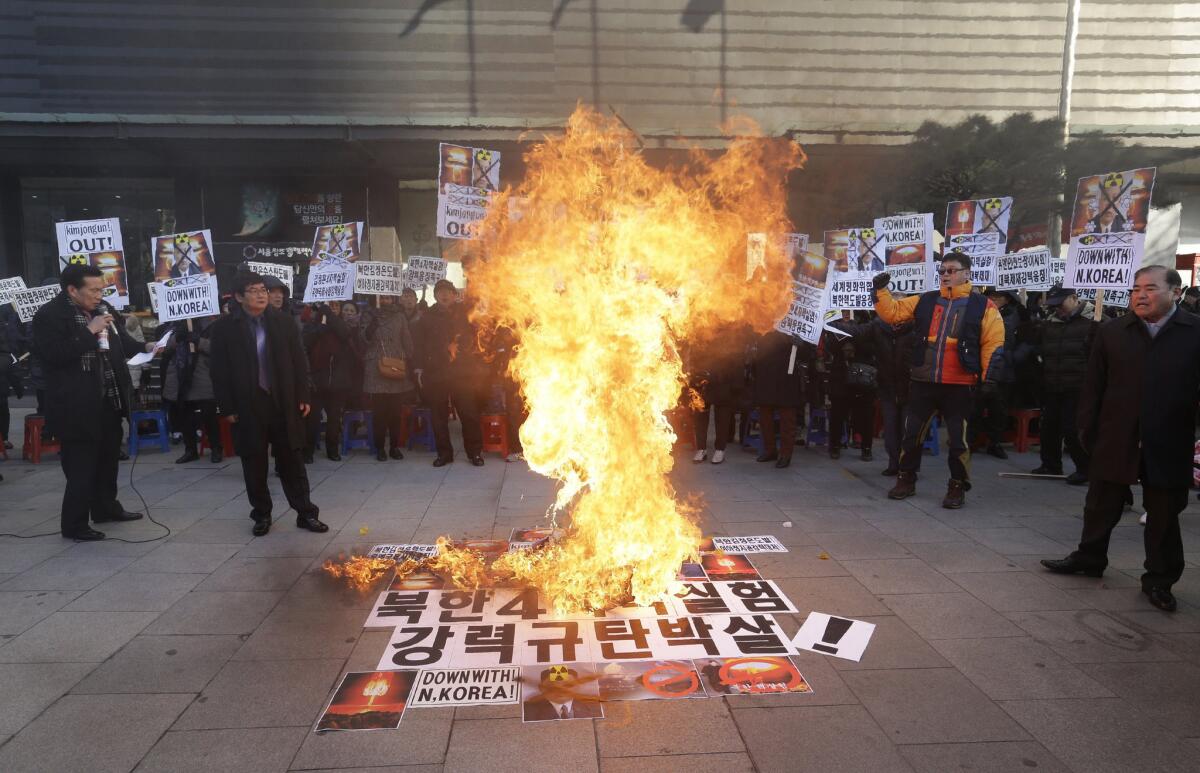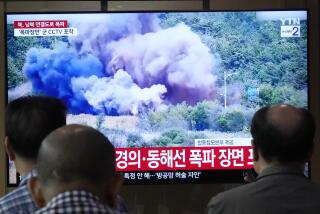South Korea to resume anti-North broadcasts in response to nuclear test

South Koreans burn North Korean leader Kim Jong Un in effigy at a Jan. 7 Seoul rally against Pyongyang’s announcement that it had tested a hydrogen bomb.
reporting from Seoul — In response to North Korea’s latest nuclear test, South Korea on Thursday announced that it would resume cross-border propaganda broadcasts that Pyongyang considers an act of war. Seoul also began talks with Washington that could see the arrival of nuclear-powered U.S. aircraft and submarines to the Korean peninsula.
From Seoul to Washington, Beijing to the United Nations, world powers are looking at ways to punish Pyongyang for the test of what it called a new and powerful hydrogen bomb.
The South’s propaganda broadcasts, which will start Friday, will infuriate authoritarian Pyongyang because they are meant to raise questions in North Korean minds about the infallibility of the ruling Kim family. The South stopped earlier broadcasts after it agreed with Pyongyang in late August on a package of measures aimed at easing animosities that had the rivals threatening war.
Experts, meanwhile, are trying to uncover more details about the detonation that drew worldwide skepticism and condemnation.
It may take weeks or longer to confirm or refute the North’s claim that it successfully tested a hydrogen bomb, which would mark a major and unanticipated advance for its still-limited nuclear arsenal. Even a test of an atomic bomb, a less sophisticated and less powerful weapon, would push its scientists and engineers closer to their goal of building a nuclear warhead small enough to place on a missile that can reach the U.S. mainland.
Statements from the White House said President Obama had spoken to South Korean President Park Geun-Hye and to Prime Minister Shinzo Abe of Japan. The statements said the countries “agreed to work together to forge a united and strong international response to North Korea’s latest reckless behavior.”
Obama also reaffirmed the “unshakeable U.S. commitment” to the security of South Korea and Japan, according to the statements.
South Korean and U.S. military leaders also discussed the deployment of U.S. “strategic assets” in the wake of the North’s test, Seoul’s Defense Ministry said Thursday.
Ministry officials refused to elaborate about what U.S. military assets were under consideration, but they likely refer to B-52 bombers, F-22 stealth fighters and nuclear-powered submarines.
When animosities sharply rose in the spring of 2013 following North Korea’s third nuclear test, the U.S. took the unusual step of sending its most powerful warplanes -- B-2 stealth bombers, F-22s and B-52s -- to drills with South Korea in a show of force. B-2 and B-52 bombers are capable of delivering nuclear weapons.
South Korea also said Thursday it will limit entry to a jointly run factory park in North Korea, the last major symbol of inter-Korean cooperation. The park’s operation won’t likely be affected much as the restriction will apply to clients, potential buyers and service providers from South Korea, rather than managers who commute to work with North Korean laborers.
The U.N. Security Council, meanwhile, held an emergency session and pledged to swiftly pursue new sanctions against North Korea, saying its test was a “clear violation” of previous U.N. resolutions.
Four rounds of U.N. sanctions have aimed at reining in the North’s nuclear and missile development programs, but Pyongyang has ignored them and moved ahead to modernize its ballistic missiles and nuclear weapons.
North Korea said Wednesday it had successfully tested a “miniaturized” hydrogen bomb that elevated the country’s “nuclear might to the next level.”
But an early analysis by the U.S. government was “not consistent with the claims that the regime has made of a successful hydrogen bomb test,” White House spokesman Josh Earnest said.
South Korea’s spy service said it thought the estimated explosive yield from the blast was much smaller than what even a failed hydrogen bomb detonation would produce.
Some believe that North Korea might have detonated a boosted fission bomb, a weapon considered halfway between an atomic bomb and an H-bomb.
But even if the North exploded a boosted fission bomb, its explosive yield, estimated at 6 kilotons, showed the test was likely a failure, Seoul’s Defense Ministry official said Thursday. An explosion two to five times more powerful would have been reported if it were successful, a ministry official said, requesting anonymity citing department rules.
After the North’s 2013 test, a yield of 6 to 7 kilotons was estimated, according to South Korean officials.
Fusion is the main principle behind the hydrogen bomb, which can be hundreds of times more powerful than atomic bombs that use fission. In a hydrogen bomb, a nuclear fission explosion sets off a fusion reaction responsible for a powerful blast and radioactivity.
The hydrogen bomb already is the global standard for the five nations with the greatest nuclear capabilities: the U.S., Russia, France, Britain and China. Other nations may either have it or are working on it, despite a worldwide effort to contain such proliferation.
Just how big a threat North Korea’s nuclear program poses is a mystery. North Korea is thought to have a handful of rudimentary nuclear bombs and has spent decades trying to perfect a multistage, long-range missile to carry smaller versions of those bombs.
Some analysts say the North probably hasn’t achieved the technology needed to make a miniaturized warhead that could fit on a long-range missile capable of hitting the U.S. mainland. But debate is growing on just how far the North has advanced.
See more of our top stories on Facebook >>
To build its nuclear program, the North must explode new and more advanced devices so scientists can improve their designs and technology. Nuclear-tipped missiles could then be used as deterrents and diplomatic bargaining chips -- especially against the U.S., which Pyongyang has long pushed to withdraw its troops from the region and to sign a peace treaty formally ending the Korean War.
U.S. aircraft designed to detect evidence of a nuclear test, such as radioactive particulate matter and blast-related noble gases, could be deployed from a U.S. base on the Japanese island of Okinawa. Japanese media said Tokyo mobilized its own reconnaissance aircraft over the Sea of Japan to try to collect atmospheric data.
ALSO
Another El Niño tantrum soaks the Southland
Is the NFL coming to L.A.? Here are the latest answers
Brown declares state of emergency at Porter Ranch amid massive gas leak
More to Read
Sign up for Essential California
The most important California stories and recommendations in your inbox every morning.
You may occasionally receive promotional content from the Los Angeles Times.










